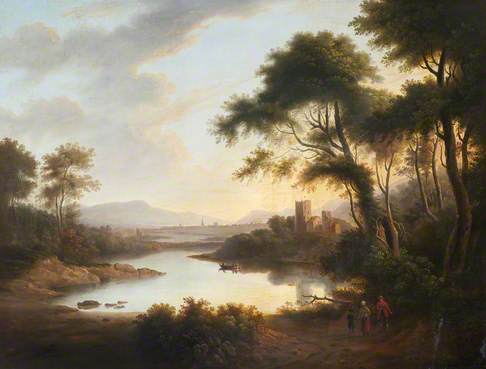Completed British 18th C, except portraits, British 19th C, except portraits, Scotland: Artists and Subjects 10 comments Can we identify the landscape depicted here, or is it a fanciful construct?

Photo credit: Royal Scottish Academy of Art & Architecture
Our work appears to be related to (copy after?) a near identical oil in Glasgow, dated to 1817. https://bit.ly/3BYrsYJ
The ruined castle at right has a European feel to it but the distant town with a prominent spire and another large building to the right of it and the mountains beyond suggest Scotland, without bringing any specific locality to mind.
Completed, Outcome
This discussion is now closed. The title and the attribution to Alexander Nasmyth have been retained.
Thank you to everyone who contributed to the discussion. To anyone viewing this discussion for the first time, please see below for all the comments that led to this conclusion.
9 comments
Louise Boreham has made a contribution via a submission: 'I think this may be a view towards Edinburgh from Craiglockhart. Arthur's Seat on left and Pentland Hills to right. It would be too much of a coincidence to have two almost identical paintings of the same scene.'
I was wondering where the date 1817 mentioned in the introduction comes from. Both paintings are marvellous - Glasgow's trees seem more credible and the low light coming through the arch and the sharp reflections almost seem the point of the painting - but the RSA's own has finer rocks on the left hand side and a neater town. I doubt it's anywhere other than somewhere one would like to be.
An almost identical work by Alexander Nasmyth’s daughter Anne Gibson Nasmyth (1798–1874) is at Hartwell House.
https://artuk.org/discover/artworks/river-landscape-with-figures-by-the-banks-a-castle-and-a-town-beyond-217465
The 1817 date appears to be a red-herring, being the date of a similarily titled painting by Nasmyth in Glasgow's collections (purchased 1960) - our mistake.
Thank you Marcie for bringing this further version to our attention - if we can crack the location (unless Donald's opinion that it is indeed a fabricated landscape is correct) then we are helping not one, but three collections.
If Louise is correct can we clarify what the middle distance town is - surely it is too flat for the famously hilly Edinburgh?
Certainly not Edinburgh and a case, I suspect, of 'too many castles' to be real (except perhaps the town, with the surroundings idealised): a ruined one on the right, a fortified tower middle-distance left, and a keep-like one in the town.
Nasmyth was a polymath and (as Donald has suggested) it looks more like an exercise in 'Scottish Claudian'. There may be comment in the two standard sources on the Nasmyths: Janet Cooksey, 'Alexander Nasmyth 1758-1840: a man of the Scottish Renaissance' (1991) and Johnson& Money on the family, 'The Nasmyth family of painters' (1977).
Thanks Pieter.
Am not readily seeing anything in Cooksey of help - perhaps due to the "attributed to" status of our and Glasgow's works.
Nasmyth of course knew the topography of Edinburgh. His many views of the city, as found by searching for images of 'Alexander Nasmyth Edinburgh', show him if anything exaggerating Caste Rock and Calton Hill. As Pieter says, this cannot be Edinburgh from any direction, and is almost certainly an invented 'Scottish' landscape. Which, if either, is the 'original' is hard to say. The townscapes look finely detailed in both Edinburgh and Glasgow versions.
In the absence of any futher comments, I would recommend maintaining the attrbution to Alexander Nasmyth, particularly in the light of the copy(?) by his daughter at Hartwell House. The location cannot be Edinburgh and is most probably an invented 'classical Scottish' landscape.
Thank you Andrew (and all other contributors) we are happy to maintain the attribution to Alexander Nasmyth and to note that the location cannot be identified, is certainly not Edinburgh, and is most probably an invented "classical Scottish" landscape.
